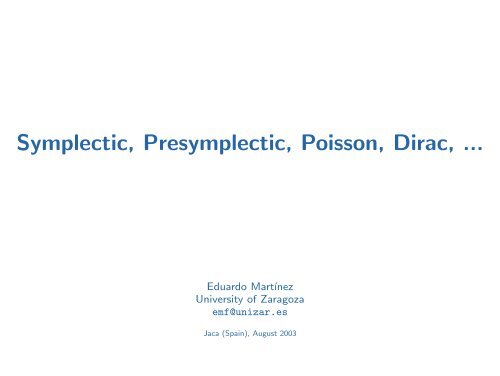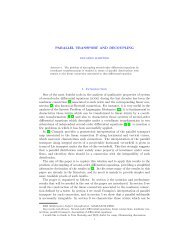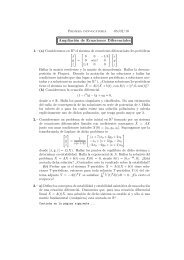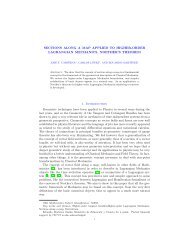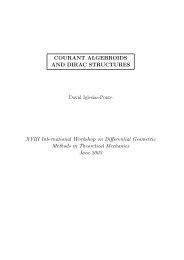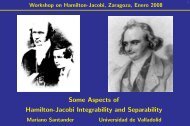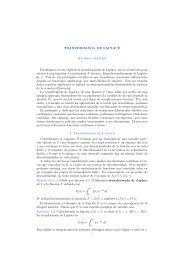Symplectic, Presymplectic, Poisson, Dirac, ...,
Symplectic, Presymplectic, Poisson, Dirac, ...,
Symplectic, Presymplectic, Poisson, Dirac, ...,
Create successful ePaper yourself
Turn your PDF publications into a flip-book with our unique Google optimized e-Paper software.
<strong>Symplectic</strong>, <strong>Presymplectic</strong>, <strong>Poisson</strong>, <strong>Dirac</strong>, ...<br />
Eduardo Martínez<br />
University of Zaragoza<br />
emf@unizar.es<br />
Jaca (Spain), August 2003
<strong>Symplectic</strong> structures<br />
Hamiltonian mechanics<br />
ẋ = ∂H<br />
∂p<br />
ṗ = − ∂H<br />
∂x .<br />
Can be written in the form ż = JdH(z):<br />
[ẋ ] [ ] [ 0 ∂H<br />
]<br />
In<br />
=<br />
∂p<br />
ṗ −I n 0<br />
∂H<br />
∂x<br />
A symplectic structure on a manifold M is a 2-form ω on M<br />
such that it is<br />
□ Closed: dω = 0.<br />
□ Non degenerated: v ↦→ ω(v, ·) has inverse.<br />
1
Pre-<strong>Symplectic</strong> structures<br />
The nondegeneration condition fails:<br />
– Singular Lagrangians<br />
– Hamiltonian mechanics with constraints<br />
– Pullback of a symplectic form to a submanifold.<br />
A presymplectic structure on a manifold M is a 2-form ω on<br />
M such that it is<br />
□ Closed: dω = 0.<br />
2
<strong>Poisson</strong> bracket<br />
In both cases we can define a <strong>Poisson</strong> algebra<br />
□ f ∈ C ∞ (M) ↦→ X f ∈ X(M) Hamiltonian vectorfield.<br />
□ {f, g} = −ω(X f , X g ).<br />
□ Hamilton equations ˙ f = {f, H}.<br />
In the presymplectic case restrict to admissible functions.<br />
f admissible ⇐⇒ ∃X ∈ X(M) s.t. i X ω = df.<br />
3
<strong>Poisson</strong> structures<br />
The <strong>Poisson</strong> bracket on the dual of a Lie algebra is not defined<br />
by a presymplectic form.<br />
Contravariant point of view: consider the inverse Λ of the symplectic<br />
form<br />
{f, g} = Λ(df, dg)<br />
and ‘allow it to be degenerate’.<br />
A <strong>Poisson</strong> structure on a manifold M is a 2-vector Λ on M such<br />
that it is closed: [Λ, Λ] = 0.<br />
Constraints are still a problem.<br />
4
<strong>Dirac</strong> structures<br />
A <strong>Dirac</strong> structure on a manifold M is a subbundle<br />
such that it is<br />
D ⊂ T ∗ M × M T M<br />
□ Maximally isotropic for ( , ) +<br />
(<br />
(α, v), (β, w)<br />
)<br />
+<br />
= 〈v, β〉 + 〈w, α〉.<br />
□ Closed:<br />
〈X 1 , L X2 α 3 〉 + 〈X 2 , L X3 α 1 〉 + 〈X 3 , L X1 α 2 〉 = 0.<br />
for all (X i , α i ) sections of D.<br />
5
□ The graph of a presymplectic form is a <strong>Dirac</strong> structure.<br />
□ The graph of a <strong>Poisson</strong> tensor is a <strong>Dirac</strong> structure.<br />
□ Restricts easily to submanifolds.<br />
□ Implicit Hamilton equations:<br />
(ẋ(t), dH(x(t))) ∈ D x(t) .<br />
□ Defines a <strong>Poisson</strong> bracket of admissible functions.<br />
f admissible ⇐⇒ ∃X ∈ X(M) s.t. (df, X) ∈ D.<br />
6
□ The manifold M is foliated by presymplectic leaves.<br />
□ The closure condition is equivalent to closure of the Courant<br />
bracket<br />
[(α, X), (β, Y )] = ( L X β − i Y dα, [X, Y ] )<br />
i.e. (D, [ , ], ρ = pr 2<br />
∣ ∣∣D<br />
) is a Lie algebroid.<br />
7
Lie Algebroids<br />
A Lie algebroid structure on the vector bundle τ : E → M is given<br />
by<br />
□ a Lie algebra structure (Sec(E), [ , ]) on the set of sections<br />
of E, and<br />
□ a morphism of vector bundles ρ: E → T M over the identity,<br />
such that<br />
[σ, fη] = f[σ, η] + (ρ(σ)f) η,<br />
where ρ(σ)(m) = ρ(σ(m)).<br />
8
Examples<br />
Tangent bundle<br />
E = T M,<br />
ρ = id,<br />
[ , ] = bracket of vector fields.<br />
Integrable subbundle<br />
E ⊂ T M, integrable distribution<br />
ρ = i, canonical inclusion<br />
[ , ] = restriction of the bracket to vector fields in E.<br />
9
Lie algebra<br />
E = g → M = {e}, Lie algebra (fiber bundle over a point)<br />
ρ = 0, trivial map (since T M = {0 e })<br />
[ , ] = the bracket in the Lie algebra.<br />
Atiyah algebroid<br />
Let π : Q → M a principal G-bundle.<br />
E = T Q/G → M, (Sections are equivariant vector fields)<br />
ρ([v]) = T π(v) induced projection map<br />
[ , ] = bracket of equivariant vectorfields (is equivariant).<br />
10
Action algebroid<br />
Let Φ: g → X(M) be an action of a Lie algebra g on M.<br />
E = M × g → M,<br />
ρ(m, ξ) = Φ(ξ)(m) value of the fundamental vectorfield<br />
[ , ] = induced by the bracket on g.<br />
11
Exterior differential<br />
On 0-forms<br />
df(σ) = ρ(σ)f<br />
On p-forms (p > 0)<br />
dω(σ 1 , . . . , σ p+1 ) =<br />
∑p+1<br />
= (−1) i+1 ρ(σ i )ω(σ 1 , . . . , ̂σ i , . . . , σ p+1 )<br />
i=1<br />
+ ∑ i
Morphism of a Lie algebroid<br />
A linear bundle map Φ: E → E ′ over ϕ: M → M ′ is a Lie<br />
algebroid morphism if pull-back commutes with d, i.e.<br />
where<br />
and<br />
Φ ∗ ◦ d = d ◦ Φ ∗ ,<br />
(Φ ∗ ω) m (a 1 , . . . , a p ) = ω ϕ(m) (Φ(a 1 ), . . . , Φ(a p )),<br />
In particular, it follows that<br />
Φ ∗ f = f ◦ ϕ.<br />
ρ ◦ Φ = T ϕ ◦ ρ.<br />
13
Hamiltonian Mechanics<br />
Prolong the dual π : E ∗ → M to a Lie algebroid π 1 : T E ∗ → E ∗<br />
T µ E ∗ = { (b, V ) ∈ E m × T µ E ∗ | T π(V ) = ρ(b) }.<br />
and anchor is ρ 1 (b, V ) = V , and the bracket makes T π : (b, V ) ↦→<br />
b a morphism.<br />
There exists a canonical 1-form<br />
θ 0 (b, V µ ) = 〈µ, b〉.<br />
The 2-form ω 0 = −dθ 0 is regular and obviously closed.<br />
Given a Hamiltonian H ∈ C ∞ (E ∗ ), the dynamical vector field is<br />
X H = ρ 1 (σ H ), where σ H is the solution of<br />
i σH ω 0 = dH.<br />
14
Lagrangian Mechanics<br />
Prolong τ : E → M to a Lie algebroid τ 1 : T E → E<br />
T a E = { (b, V ) ∈ E m × T a E | T τ(V ) = ρ(b) }.<br />
and anchor is ρ 1 (b, V ) = V , and the bracket makes T τ : (b, V ) ↦→<br />
b a morphism.<br />
Given a Lagrangian L ∈ C ∞ (E), there exists a 1-form<br />
θ L (b, V a ) = ξ V a (b)L.<br />
The 2-form ω L = −dθ L is obviously closed and it is regular iff<br />
∂ 2 L/∂y∂y is regular.<br />
The dynamical vector field is ρ 1 (Γ), where Γ is the solution of<br />
i Γ ω L = dE L .<br />
15
<strong>Symplectic</strong> Lie algebroids<br />
A presymplectic form on a Lie algebroid E is a 2-form on E,<br />
Ω: E ∧ E → R, which is closed with respect to the differential in<br />
the Lie algebroid: dω = 0 .<br />
A symplectic form on a Lie algebroid is a nondegenerated<br />
presymplectic form on E.<br />
(M, Ω) presymplectic manifold<br />
↕<br />
(T M, Ω) presymplectic Lie algebroid<br />
16
Hamiltonian sections<br />
Hamiltonian section σ f<br />
C ∞ (M)<br />
defined by an admissible function f ∈<br />
i σf Ω = df.<br />
Hamiltonian vectorfield X f = ρ(σ f ).<br />
<strong>Poisson</strong> bracket of two admissible functions<br />
{f, g} = −Ω(σ f , σ g ).<br />
In particular<br />
If Ω is symplectic, the base M is <strong>Poisson</strong><br />
17
Compatibility<br />
A 2-form Ω is compatible with the Lie algebroid structure if<br />
ker ρ ⊂ ker Ω.<br />
Theorem 1 If a presymplectic form Ω is compatible, then the<br />
leaves of the Lie algebroid are presymplectic manifolds. In that<br />
case, the leaves are symplectic if and only if ker ρ = ker Ω.<br />
Proof: ω L (v, w) = Ω(a, b) for ρ(a) = v and ρ(b) = w. Thus<br />
Ω| EL = ρ ∗ ω L .<br />
18
Theorem 2 If Ω is a compatible presymplectic form on E and<br />
Φ: Ē → E is a morphism, then ¯Ω = Φ ∗ Ω is a compatible presymplectic<br />
form on Ē.<br />
Proof: If a ∈ ker ¯ρ then Φ(a) ∈ ker ρ because ρ(Φ(a)) =<br />
T ϕ(¯ρ(a)).<br />
Therefore Φ(a) ∈ ker Ω.<br />
Thus ¯Ω(a, b) = Ω(Φ(a), Φ(b)) = 0 for all b, i.e. b ∈ ker ¯Ω.<br />
19
Quotient by the kernel<br />
<br />
<br />
The kernel of Ω is a Lie subalgebroid:<br />
i [σ1,σ 2]Ω = d σ1 i σ2 Ω = 0.<br />
We can quotient by ker Ω<br />
ker Ω <br />
E <br />
p<br />
E/ ker Ω<br />
τ<br />
M M/ρ(ker Ω)<br />
provided that some regularity properties are asumed.<br />
20
The form Ω defines a form ¯Ω in the quotient<br />
¯Ω [m] ([a], [b]) = Ω m (a, b)<br />
Since p is a morphism, then ¯Ω is closed and by construction is<br />
regular, therefore it is symplectic.<br />
It follows that<br />
M/ρ(ker Ω) is a <strong>Poisson</strong> manifold<br />
21
Canonical form on a <strong>Dirac</strong> structure<br />
Let D be an almost-<strong>Dirac</strong> structure on a manifold M. The canonical<br />
2-form on D is the 2-form Ω defined by<br />
Ω((α, v), (β, w)) = 〈v, β〉 = −〈w, α〉.<br />
Proposition 1 The kernel of Ω is ker Ω = ker ρ ⊕ ker λ, where<br />
λ: D → T ∗ M is the projection onto the first factor. In particular,<br />
Ω is compatible with the Lie algebroid structure.<br />
Proof:<br />
a = (α, v) ∈ ker ρ iff v = 0. Thus<br />
Ω(a, b) = 〈0, β〉 = 0<br />
for all b = (w, β) ∈ D<br />
22
Closed iff Closed<br />
Theorem 3 An almost-<strong>Dirac</strong> structure D on a manifold M is<br />
closed (i.e. it is a <strong>Dirac</strong> structure) if and only if<br />
∑ (<br />
)<br />
ρ(σ i )Ω(σ j , σ k ) − Ω([σ i , σ j ], σ k ) = 0<br />
ciclic(i,j,k)<br />
for all σ i , σ j , σ k sections of D.<br />
23
Proof:<br />
∑<br />
ciclic(i,j,k)<br />
(<br />
)<br />
ρ(σ i )Ω(σ j , σ k ) − Ω([σ i , σ j ], σ k ) =<br />
∑<br />
ciclic(i,j,k)<br />
∑<br />
ciclic(i,j,k)<br />
∑<br />
ciclic(i,j,k)<br />
(<br />
)<br />
ρ(σ i )〈ρ(σ j ), λ(σ k )〉 − 〈ρ([σ i , σ j ]), λ(σ k )〉 =<br />
(<br />
)<br />
X i 〈X j , α k 〉 − 〈[X i , X j ], α k 〉<br />
〈X j , L Xi α k 〉.<br />
=<br />
24
<strong>Dirac</strong> structures<br />
are particular cases of<br />
compatible presymplectic Lie<br />
algebroids.<br />
25
Gauged<br />
Given a closed 2-form ω on the manifold M we can define the Lie<br />
algebroid<br />
E = { (α + ω(v), v) | (α, v) ∈ D }<br />
with the Courant bracket. Notice that E is a Lie algebroid but<br />
it is not a <strong>Dirac</strong> structure. It is said to be obtained by a gauge<br />
transformation from D.<br />
Nevertheless, there also exists a 2-form<br />
which is closed.<br />
¯Ω(a, b) = 〈ρ(a), λ(b)〉<br />
26
The map Φ: D → E given by Φ(α, v) = (α + B(v), v) is an<br />
isomorphism of Lie algebroids and we have Φ ∗ ¯Ω = Ω − ρ ∗ ω.<br />
Therefore gauge equivalent <strong>Dirac</strong> structures have the same leaves<br />
but the presymplectic structure on every leaf is different.<br />
27
Twisted<br />
Given a closed 3-form φ on the manifold M we can modify the<br />
Courant bracket<br />
[(α, X), (β, Y )] = (L X β − i Y dα + φ(X, Y, ·), [X, Y ]).<br />
A φ-twisted <strong>Dirac</strong> structure is an almost <strong>Dirac</strong> structure which is<br />
closed under the above bracket.<br />
An almost <strong>Dirac</strong> structure D is a φ-twisted <strong>Dirac</strong> structure if and<br />
only if<br />
dΩ + ρ ∗ φ = 0.<br />
28
Conclusions and open problems<br />
□ <strong>Symplectic</strong> and presymplectic forms on Lie algebroids appears<br />
naturally in the study of some dynamical systems, and<br />
are as easy to use as ordinary presymplectic forms.<br />
□ Most (all?) geometric constructions on <strong>Dirac</strong> structures<br />
are but a consequence of the existence of the presymplectic<br />
structure.<br />
□ There is a well known constraint algorithm for presymplectic<br />
forms.<br />
□ The theory of symmetries for presymplectic forms leads to<br />
the results by Blankenstein and Van der Schaft about symmetries<br />
of <strong>Dirac</strong> structures.<br />
29
□ A <strong>Dirac</strong> structure integrates to a presymplectic groupoid.<br />
What is the integration of a compatible presymplectic Lie<br />
algebroid?<br />
□ Non-compatible symplectic forms are also of interest. What<br />
is the integration of a non-compatible presymplectic Lie algebroid?<br />
□ Jacobi versions?<br />
30
In collaboration with Jesús Clemente-Gallardo, University of Coimbra.<br />
The end<br />
31


